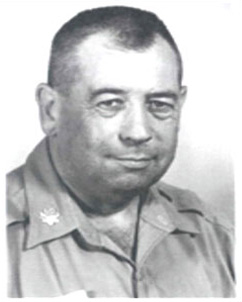Lieutenant Colonel
Karl L. Zilske
 Karl L. Zilske, born on
June 6, 1912, in Appleton, Wisconsin, enlisted in the Medical Service Corps in 1941, attaining the rank of staff
sergeant and serving as acting First Sergeant in the 30th Veterinary General Hospital. He then attended Ordnance
Officer Candidate School at Aberdeen Proving Ground (APG), Maryland, where he was commissioned as a second
lieutenant in October 1942. He next graduated from the Bomb Disposal School at Aberdeen and in 1943 was on his way
to the Pacific with the 232d Bomb Disposal Company.
Karl L. Zilske, born on
June 6, 1912, in Appleton, Wisconsin, enlisted in the Medical Service Corps in 1941, attaining the rank of staff
sergeant and serving as acting First Sergeant in the 30th Veterinary General Hospital. He then attended Ordnance
Officer Candidate School at Aberdeen Proving Ground (APG), Maryland, where he was commissioned as a second
lieutenant in October 1942. He next graduated from the Bomb Disposal School at Aberdeen and in 1943 was on his way
to the Pacific with the 232d Bomb Disposal Company.
Zilske and the 232d trained in Hawaii, gaining experience clearing duds from training ranges and disposing of dynamite-filled land mines that had become dangerously unstable. The company was then reorganized into separate bomb disposal squads and Zilske took command of the 97th. He led his squad through amphibious landings on Eniwetok, Kwajalein, Saipan, and Okinawa, winning a Bronze Star on Saipan for devising a modified fuse that allowed aircraft to drop depth charges on land targets, thus alleviating a bomb shortage. He served briefly at war's end as Assistant Ordnance Officer with the 10th Army.
Discharged as a captain in 1946, Zilske returned to the Army in 1948, serving in the Research and Analysis Branch of the Ordnance School at APG. He next took command of the newly activated 16th Bomb Disposal Squad at APG and moved it to Fort Bliss, Texas, in 1949. In 1950, he returned to APG to serve as a project officer with the Ordnance Board. From 1952 to 1955, he served in the Ordnance Division in Headquarters United States Army Europe as the Explosive Ordnance Disposal (EOD) Officer and then as Executive Officer of the Ammunition Branch.
By now an expert in all aspects of EOD, Zilske returned to APG in 1955 to work in the EOD Office, first as Chief of the Research and Development Branch, and then as Deputy Chief. In 1958, he was en route to South Vietnam as part of a special team called the Temporary Equipment Recovery Mission charged with recovering $700 million of US military equipment left behind by the French when they left Vietnam. In addition, Zilske spent much of his time advising the fledgling Army of South Vietnam on ammunition operations and procedures for dealing with booby traps.
He returned to the United States in 1959 to work at the Ordnance Ammunition Command at Joliet, Illinois, eventually serving as Chief of the Maintenance Branch and then as Chief of the Safety Office. In his final tour of duty from 1961 to 1964, Zilske served as Commander of the Louisiana Army Ammunition Plant in Shreveport. Lieutenant Colonel Zilske retired in 1964 but continued to serve the cause of the Army's ammunition program, working first for the Sperry Rand Corporation as Chief of Maintenance at the Louisiana Army Ammunition Plant and then from 1965 to 1971 for the Uniroyal Corporation as Safety Engineer at the Joliet Army Ammunition Plant. Karl Zilske died in 1975 in Joliet, Illinois.